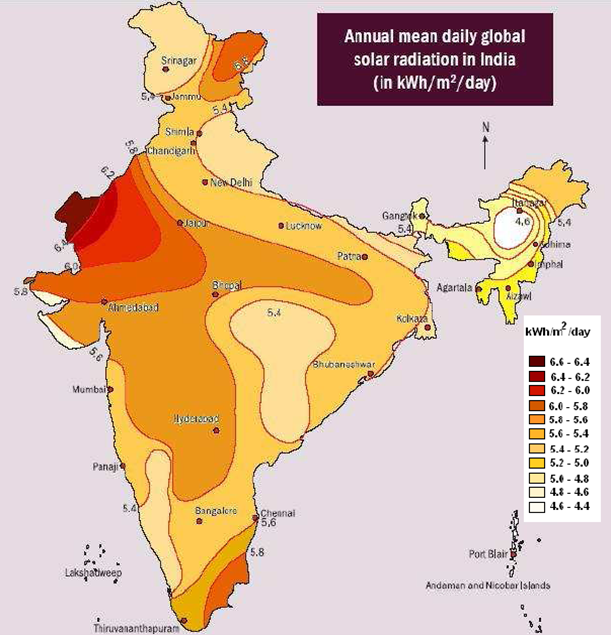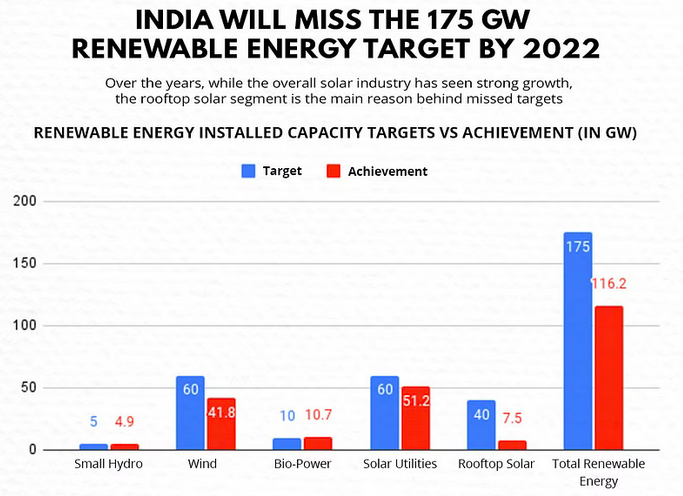ForumIAS announcing GS Foundation Program for UPSC CSE 2025-26 from 19 April. Click Here for more information.
Contents
| For 7PM Editorial Archives click HERE → |
Introduction
India has undertaken ambitious targets under the Paris Agreement. India’s climate action is dependent upon energy transition (in the electricity sector) by betting large on shift to solar energy. In 2014-15, the Government had set a target of producing 175 Gigawatt (GW) of renewable energy by 2022, with 100 GW of solar energy. The present installed capacity of solar energy is only 60% of the target. While, the Government is set to miss the ambitious target, nevertheless the progress in expansion of renewable and solar energy has been commendable. The installed renewable energy capacity has trebled from 38GW in 2014. The Government should take steps to address the challenges facing the sector and further enhance the pace of transition to clean energy.
What are the Potential, Targets and Status of Solar Energy in India?
Potential
India is endowed with vast solar energy potential. India receives nearly 3000 hours of sunshine every year. About 5,000 trillion kWh per year energy is incident over India’s land area with most parts receiving 4-7 kWh per sq. m per day. Solar photovoltaics power can effectively be harnessed providing huge scalability in India.
National Institute of Solar Energy has assessed India’s solar potential to be about 750 GW assuming 3% of the waste land area to be covered by Solar PV modules.
Gujarat and Rajasthan have the highest solar energy potential.
Source: Ministry of New and Renewable Energy (MNRE)
Targets
In 2014, the Government had set an ambitious target of 175 GW of installed capacity of renewable energy. The target for Solar Energy was set to be 100 GW by 2022.
At COP26 in Glasgow (2021) India updated its Nationally Determined Contributions (NDCs). India set a target of 500 GW of non-fossil electricity capacity and half of energy from renewables. Of this, ~300 GW is expected to be contributed by Solar Energy.
A 25-year vision document by the Government has targeted 85% of the power generation from renewable and green sources of energy. This enables India to be one of the key markets for solar energy and also a huge customer base for solar applications.
Bloomberg New Energy Finance (BNEF) estimates in its NEO 2018 report, that India will generate 75% of its electricity from renewable energy sources by 2050.
Status
India’s current installed capacity stands at ~408 GW, of which renewable energy (Wind, Solar and other renewable energy) is ~118GW. This is ~67% of the 175 GW target set in 2014. In terms of Solar Energy, the installed capacity is ~60 GW which is ~60% of the 100 GW target (2014). This has been a remarkable growth from just 2.6 GW of solar energy capacity in 2014.
Source: The Print
The top States in terms of installed solar energy capacity (March 2021) include: Karnataka (7.35 GW), Rajasthan (5.73 GW), Tamil Nadu (4.47 GW), Gujarat (4.43 GW) and Andhra Pradesh (4.2 GW).
What are the challenges in scaling up Solar Energy?
Higher per-unit Production Costs: Solar power costs have come down considerably but the costs of small solar power projects is higher than other sources. The Union Government is facilitating establishment of large solar parks.
Basic Challenges: Large Solar Parks face hurdles in acquiring large tracts of land. Other challenges include high transmission and distribution losses, grid integration etc. Grid integration is a challenge due to intermittent nature of solar energy and the problem of load balancing (e.g., high load during night but non-availability of solar power at night).
Environmental Issues: Establishment of large solar parks has led to conflict with the local communities and issues in bio-diversity protection e.g., in Rajasthan and Gujarat, some projects have been halted because the transmission lines encroach upon the habitat of the critically endangered Great Indian Bustard.
Slow pace of growth: Despite significant growth in the installed solar capacity, the contribution of solar energy to the country’s power generation has not grown at the same pace. The capacity expansion of rooftop solar projects has particularly low (< 20% of target by October 2022).
Financial Constraints: Residential consumers and Small and Medium Enterprises (SMEs) who want to install solar rooftop projects face financial constraints as initial investments are generally high. A critical issue is an absence of innovative financing options offering higher sums at lower interest and longer durations.
Reliance on Imports for Solar Equipment: India at present lacks the capability to produce solar wafers or polysilicon. During the fiscal year 2021-22, India imported solar cells and modules worth about US$ 76.62 billion from China alone. This accounted for 78.6% of India’s total imports (2021-22).
Waste Management: India’s solar waste is estimated to grow to 1.8 million tonnes by 2050. However, India’s e-waste rules do not mandate solar cell manufacturers to recycle or dispose of waste from this sector.
WTO Constraints: India’s Domestic Content Requirement (DCR) clause has faced legal challenges at the World Trade Organisation (WTO). DCR mandates the use of both solar cells and modules manufactured domestically as per specifications and testing requirements fixed by the Ministry of New and Renewable Energy (MNRE).
What steps have been taken to enhance Solar Energy generation in India?
The MNRE launched the Jawaharlal Nehru National Solar Mission in 2010 to achieve 20 GW of grid connected solar power by 2022 in three phases through several steps including Solar Park Scheme, Central Public Sector Undertakings (CPSUs) scheme for grid connected solar PV power projects, and Viability Gap Funding (VGF). The target was revised to 100 GW in 2014-15.
The Government has also launched the Pradhan Mantri Kisan Urja Suraksha Uttan Mahabhiyan Yojana (PM-KUSUM) for grid connected agricultural solar pumps.
Suryamitra Skill Development Programme by the National Institute of Solar Energy (NISE) focuses on Solar Energy project’s installation, operation & maintenance.
Atal Jyoti Yojana has been launched to provide solar street lighting systems for public use.
Under the Solar Transfiguration of India (SRISTI) Scheme, financial incentives are provided to the beneficiary for installing solar power plant rooftop projects.
Green Energy Corridor Scheme: It is related to laying of new transmission lines and creating new sub-station capacity for evacuation (from region of production to region of consumption) of renewable power.
In 2014, the Government announced the ‘Solar Parks and Ultra-Mega Solar Power Projects’ policy to facilitate the creation of large solar parks.
The Government has also provided financial incentives for expansion of solar energy. These include: (a) The Government has provided a 10-year tax exemption for solar energy projects; (b) Waiver of Inter-State Transmission System (ISTS) charges for inter-state sale of solar and wind power for projects to be commissioned by 30th June 2025; (c) The Ministry of New and Renewable Energy provides 30% subsidy to most solar powered items such as solar lamps and solar heating systems. It has further extended its subsidy scheme to solar-powered cold storages; (d) The Government has allowed 100% Foreign Direct Investment (FDI) under the automatic route; (e) Government has issued orders that power shall be dispatched against Letter of Credit (LC) or advance payment to ensure timely payment by distribution licensees to renewable energy generators; (f) Government has also launched Green funds like the National Clean Energy and Environmental Fund, Green Masala Bond etc.
The Government has also undertaken initiatives for international collaboration. India is the founding member of the International Solar Alliance (ISA) which is headquartered in India. India has proposed the idea of “One Sun, One World, One Grid” as a means of tapping into the copious solar electricity available on a worldwide scale.
What should be done going ahead?
Manufacturing of Solar Equipment: Manufacturing of solar equipment is dominated by a handful number of countries. In order to become a world leader in solar power, India must develop the entire manufacturing value chain ecosystem to become competitive and achieve sustainable growth in the long run.
Last mile connectivity: The Government should also focus on last mile connectivity in remote areas where developing transmission infrastructure is a challenge. This can be achieved through small solar installations or solar community grids by using domestically manufactured products with small power inverters or batteries in every home. It may be helpful to ensure power for all.
Investment in New Technology: The Government should invest prudently in new and emerging solar technologies through strong financial measures that include green bonds, clean energy funds and institutional loans.
Promote R&D: There is a need to promote R&D particularly in renewable energy storage technology and tackle bureaucratic hurdles in implementation of such efforts.
India must also take proactive steps towards formulation of an efficient Solar PV Waste Management and Manufacturing Standards Policy for sustainable waste management.
Technology Diplomacy: The Government should also leverage on the Ministry of External Affairs’s New and Emerging Strategic Technologies (NEST) Division to engage in technology diplomacy and negotiate technology governance to favour India.
Conclusion
Although the Solar Energy target set for 2022 will be missed, the Union and State Governments have done well in facilitating the capacity expansion of solar energy. The Governments should continue to undertake policy reforms and provide financial and other incentives to the industry, so that India can enhance its climate action and fasten the pace towards Net Zero.
Syllabus: GS III, Energy; Conservation, Environmental Pollution and Degradation.
Source: The Hindu, The Hindu, MNRE, Ministry of Power






